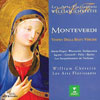Monteverdi Vespro della Beata Vergine
View record and artist detailsRecord and Artist Details
Composer or Director: Claudio Monteverdi, Giovanni Paolo Cima
Genre:
Vocal
Label: Erato
Magazine Review Date: 10/1998
Media Format: CD or Download
Media Runtime: 100
Mastering:
DDD
Catalogue Number: 3984 23139-2

Tracks:
| Composition | Artist Credit |
|---|---|
| Vespro della Beata Vergine, 'Vespers' |
Claudio Monteverdi, Composer
(Les) Arts Florissants Chorus (Les) Arts Florissants Orchestra (Les) Sacqueboutiers de Toulouse Artur Stefanowicz, Alto Claudio Monteverdi, Composer Clive Bayley, Bass Fabian Schofrin, Alto François Piolino, Tenor Joseph Cornwell, Tenor Maryseult Wieczorek, Soprano Paul Agnew, Tenor Sophie Marin-Degor, Soprano Thierry Félix, Bass William Christie, Organ William Christie, Harpsichord |
| Concerti ecclesiastici, Movement: Sonata per il violino, cornetto e violone |
Giovanni Paolo Cima, Composer
(Les) Arts Florissants Instrumental Ensemble Giovanni Paolo Cima, Composer |
| Concerti ecclesiastici, Movement: Sonata per il violino e violone |
Giovanni Paolo Cima, Composer
(Les) Arts Florissants Instrumental Ensemble Giovanni Paolo Cima, Composer |
Author: David Fallows
This is in some ways an oddly old-fashioned approach to the 1610 Vespers. With a substantial choir and sometimes highly varying orchestration, William Christie creates a warm and glowing sound. Part of his emphasis is on texture and flow, so Monteverdi’s often sharp dissonances tend to have a soft edge; and there are some occasionally irrelevant pitches buried in the polyphonic web.
While Christie is inclined to ignore current orthodoxies about such matters as the place of a harpsichord or a continuo cello and double-bass in this music, he does accept others. In particular he faces the challenge of putting the “Lauda Jerusalem” and the “Magnificat” at a pitch-standard a fourth lower than the rest (which he has at a modern concert pitch). And that is where the rich orchestration pays its dividends; the resulting almost impossibly low bass-lines, particularly in the “Et misericordia” section of the “Magnificat”, sound clear and lucid with their instrumental doubling. He also benefits from the splendid low range of the tenors he uses: they manage to make the “Gloria Patri” section a true climax to the work, and in particular they give the “Duo Seraphim” perhaps the most convincing performance available anywhere because they are so beautifully matched.
As far as the formal structure is concerned, Christie prefaces each of the psalms with a chant introit; and he follows the order of the print except in putting “Duo Seraphim” before the “Sonata sopra Sancta Maria” (despite the implication in IF’s note that this is unnecessary). To fill the gap where Monteverdi put “Duo Seraphim” he introduces a sonata by Giovanni Paolo Cima, superbly played by a team led by the violinist, Francois Fernandez; and another excellently performed sonata by Cima separates the “Lauda Jerusalem” from “Duo Seraphim”.
There are so many other recordings of the 1610 Vespers that it is hard to know quite where this fits in. For dramatic excitement and incisive choral singing, Gardiner’s most recent version has no challengers; for absolute clarity of texture one must still return to Parrott; and for sheer formal elegance I continue to treasure Pickett. But there is a warmth and generosity here that are undeniably attractive; the movements I have mentioned go better than anything else available; and everything is done at the level of skill and musicality that we have come to expect from Christie and Les Arts Florissants.'
While Christie is inclined to ignore current orthodoxies about such matters as the place of a harpsichord or a continuo cello and double-bass in this music, he does accept others. In particular he faces the challenge of putting the “Lauda Jerusalem” and the “Magnificat” at a pitch-standard a fourth lower than the rest (which he has at a modern concert pitch). And that is where the rich orchestration pays its dividends; the resulting almost impossibly low bass-lines, particularly in the “Et misericordia” section of the “Magnificat”, sound clear and lucid with their instrumental doubling. He also benefits from the splendid low range of the tenors he uses: they manage to make the “Gloria Patri” section a true climax to the work, and in particular they give the “Duo Seraphim” perhaps the most convincing performance available anywhere because they are so beautifully matched.
As far as the formal structure is concerned, Christie prefaces each of the psalms with a chant introit; and he follows the order of the print except in putting “Duo Seraphim” before the “Sonata sopra Sancta Maria” (despite the implication in IF’s note that this is unnecessary). To fill the gap where Monteverdi put “Duo Seraphim” he introduces a sonata by Giovanni Paolo Cima, superbly played by a team led by the violinist, Francois Fernandez; and another excellently performed sonata by Cima separates the “Lauda Jerusalem” from “Duo Seraphim”.
There are so many other recordings of the 1610 Vespers that it is hard to know quite where this fits in. For dramatic excitement and incisive choral singing, Gardiner’s most recent version has no challengers; for absolute clarity of texture one must still return to Parrott; and for sheer formal elegance I continue to treasure Pickett. But there is a warmth and generosity here that are undeniably attractive; the movements I have mentioned go better than anything else available; and everything is done at the level of skill and musicality that we have come to expect from Christie and Les Arts Florissants.'
Discover the world's largest classical music catalogue with Presto Music.

Gramophone Digital Club
- Digital Edition
- Digital Archive
- Reviews Database
- Full website access
From £8.75 / month
Subscribe
Gramophone Full Club
- Print Edition
- Digital Edition
- Digital Archive
- Reviews Database
- Full website access
From £11.00 / month
Subscribe
If you are a library, university or other organisation that would be interested in an institutional subscription to Gramophone please click here for further information.




